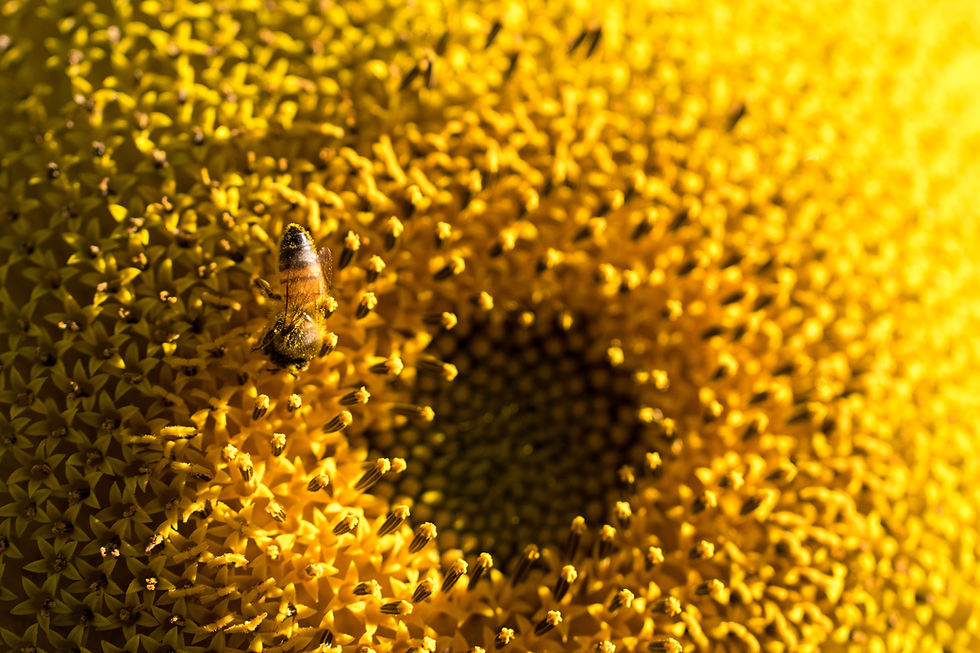Why sunflowers are the best bloomers
- activateeditor
- Dec 4, 2020
- 4 min read
by Carmen Visser
“Sunflowers end up facing the sun, but they go through a lot of dirt to find their way there.” – J.R. Rim

According to the University of Arizona, sunflowers were first grown by Native Americans, who used them as a source of food and oil. From there, they were transported and planted in different parts of the world. Sunflowers can now be found on all continents, except Antarctica.
A sunflower head is a collection of hundreds of individual flowers. The fuzzy brown centre consists of many separate flowers and each petal is considered a flower of its own. This is called “inflorescence”, which means many flowers within a flower.
Sunflowers, like many other plants, absorb carbon dioxide from the air through the process of photosynthesis. They also soak up toxins from the soil, such as nuclear radiation. The towering flowers are well-known for their large brown heads and yellow petals. However, there are 70 different species of the flower, including the Chianti sunflower which has red petals.
My favourite sunflower species is one which is thought to be cuddly - the teddy bear sunflower. This species is as cute as its name. The flower with fluffy double blooms grows easily and consistently, according to Gardenia.
“If I were a flower, I would be a sunflower. To always follow the sun, turn my back to darkness, stand proud, tall and straight even with my head full of seeds.” – Pam Stewart

Young sunflowers will follow the sun with their head from dawn to dusk. They repeat this process daily until they mature and face eastwards. These mature sunflowers face eastwards for the simple reason that they will attract more bees and birds, who enjoy the warm east-facing plants over the cold west-facing ones.
These bees and birds immensely help the cross-pollination process. However, sunflowers do not rely solely on bees and birds for their species continuation. They can pollinate themselves through a process called homogamy, where the stigma of the flower bends and makes contact with the anthers, starting the fertilization process.
Most sunflower species can be grown from a seedling and follow the same growth process – seedling, germination, bud growth, flowering, pollination, seed development and harvesting.
As expected, sunflowers need full sunlight to thrive. There is a belief that sunflowers face each other on cloudy days, but sadly this is not true. Young sunflowers will continue to follow the sun’s path, even if the sun’s rays are blocked by clouds and mature sunflowers continue to face eastwards.
Although the myth that sunflowers face each other is untrue, I like to believe that we can still adapt it into our lives. We can learn to lean on those around us during the dark and difficult times.
Garden Trivia suggests that in a field of mature sunflowers facing eastwards, there is always a rebel who faces in their chosen direction. I like to think that I act as a rebel sunflower in the human world by drifting away from society’s expectations and social norms.

“We’re all golden sunflowers inside.” – Allen Ginsberg
The process of extracting oil and seeds from sunflowers, discovered by Native Americans, is a globally known activity. Sunflower oil is multi-purpose and can be used all over the house. Vegetable oil, made from sunflowers, is an excellent replacement for olive oil, butter and margarine. With less saturated fat, this oil is a much healthier choice for cooking and baking.
In addition, sunflower oil can be used as a massage oil and has an anti-inflammatory effect. Many suggest it for homemade skincare, especially as it does not have a pungent smell. The vegetable flower oil has also proven successful in lowering cholesterol levels.
One can also extract seeds from sunflowers. These seeds can be crunched on as a snack, added to a breakfast bowl with yoghurt and muesli or even replace coffee beans. Yes, you can grind the seeds and steep them with boiling water to make a healthy and tasty caffeine substitute. There truly is nothing that a sunflower cannot do.

“Despite knowing they won’t be here for long, they choose to live their brightest lives – sunflowers.” – Rupi Kaur
Sunflowers are cherished and loved by many across the globe. Artists such as Vincent Van Gogh, Jacob Epstein and Frank Brangwyn have created stunning pieces centred around the blooming flowers.
Poets and writers have also encompassed sunflowers into their writing. For example, Rupi Kaur and her poem “sunflowers”, as well as Simon Wiesenthal and his novel, “The Sunflower”.
Personally, I cannot help but fall in love with these beautiful giants. They symbolise many of the positive aspects of life, such as sunshine, strength and survival.
As you are now dying to see arrays of sunflowers, you can find sunflower fields in these three South African locations:
Between Bloemfontein and Johannesburg, visible from the N1 highway
Located near town of Magaliesberg
Loskop, Mpumalanga
Be sure to visit during September and October to see them in full bloom!
“A sunflower field is like a sky with a thousand suns.” – Corina Abdulahm-Negura










Comments